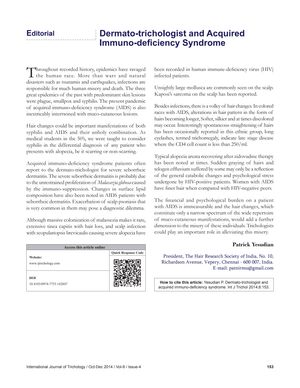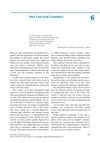Dermatotrichologist and Acquired Immunodeficiency Syndrome
January 2014
in “
International Journal of Trichology
”
seborrheic dermatitis Malassezia globosa surface lipid composition tinea capitis scopulariopsis brevicaulis alopecia mollusca Kaposi's sarcoma trichomegaly alopecia areata zidovudine therapy graying of hairs telogen effluvium trichologists Malassezia scopulariopsis hair loss long eyelashes zidovudine gray hair hair shedding hair specialists

TLDR Hair changes are common in AIDS patients and can add to their financial and emotional stress.
In the context of the AIDS pandemic, hair changes are significant manifestations that can be observed by dermato-trichologists. Patients with AIDS often present with severe seborrheic dermatitis, likely due to the overgrowth of Malassezia globosa as a result of immunosuppression. Additionally, changes in surface lipid composition in these patients have been noted. Other hair-related issues in HIV-infected patients include extensive tinea capitis with hair loss, scalp infection with scopulariopsis brevicaulis causing severe alopecia, and unsightly large mollusca on the scalp. Kaposi's sarcoma on the scalp has also been reported. In patients of color with AIDS, hair may become longer, softer, silkier, and sometimes discolored, with spontaneous straightening occasionally observed. Trichomegaly, or long eyelashes, indicates a late stage of the disease with a CD4 cell count less than 250/ml. Some patients experience typical alopecia areata that recovers after zidovudine therapy, sudden graying of hairs, and telogen effluvium, which may reflect the general catabolic changes and psychological stress of HIV-positive patients. Women with AIDS have been observed to have finer hair compared to HIV-negative individuals. These hair changes add to the financial and psychological burden of patients with AIDS, and trichologists have an important role in helping to alleviate some of this misery.




